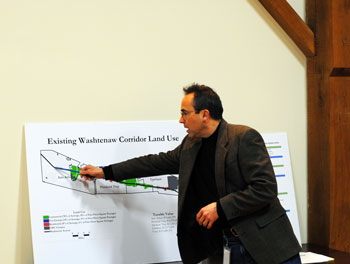What Does Washtenaw Corridor Need?
At the Ann Arbor city council’s March 7, 2011 meeting, a visitor from the east – Ypsilanti mayor Paul Schreiber – spoke during a public hearing, calling Washtenaw Avenue a “lifeline” between Ann Arbor and Ypsilanti. The road cuts through four jurisdictions: Ann Arbor, Ypsilanti, Ypsilanti Township and Pittsfield Township. The four local governmental units have been collaborating over the last two years to find ways to improve how the Washtenaw corridor functions – in terms of traffic flow, and future business/residential development.

City of Ann Arbor planner Jeff Kahan explains that even though the proposed district boundaries of a Washtenaw Avenue corridor improvement authority would, at its western end, not include properties adjoining the right-of-way, the right-of-way could still receive the benefit of improvements. (Photos by the writer.)
That’s what the public hearing was about. The Ann Arbor city council is considering whether to work with the other three communities to establish a corridor improvement authority (CIA) along Washtenaw Avenue. Schreiber was at Ann Arbor’s meeting to encourage the council to consider forming a CIA, thus joining with his city and the two other municipalities along Washtenaw. The council took no action on March 7 – by state statute, they cannot take the step to establish a CIA until 60 days after the public hearing.
A corridor improvement authority is a tax-increment finance district, similar to a downtown development authority – but specifically designed for commercial corridors instead of downtown areas. [.pdf map of proposed Washtenaw Avenue CIA district ] At the March 7 public hearing on establishing a Washtenaw Avenue CIA, Schreiber was one of only two people to speak.
But five days earlier, on March 2, around 20 people attended a presentation by city of Ann Arbor planners at Cobblestone Farm. And they were joined late in the meeting by Stephen Rapundalo, who represents Ward 2 on the Ann Arbor city council. Washtenaw Avenue is a boundary between Ward 2 on the north and Ward 3 on the south. Some of those 20 residents aired their criticisms as well as support of the CIA proposal. In addition to some concerns about the administration of the authority, attendees expressed disagreement with each other about the kinds of solutions the corridor needs.
Some agreed with the conclusions of a joint technical committee that’s been working on the issue: The corridor would benefit from added transit infrastructure and greater accessibility to non-motorized transportation, as well as increased residential density. Others saw that stretch of Washtenaw Avenue as needing mainly additional lanes in the roadway to improve traffic flow.
On the administrative side, city planner Jeff Kahan explained that the possibility of establishing a CIA along Washtenaw Avenue would be greatly helped by a revision to the relatively new state statute that allows such CIAs to be created – a revision that would explicitly articulate that the four jurisdictions could form a single authority. As the statute is currently written, four separate authorities would need to be formed, and then operated under some kind of inter-governmental agreement.
So where did this idea come from that four separate units of government might collaborate on creating a corridor improvement authority for Washtenaw Avenue? It pre-dates by at least two years Gov. Rick Snyder’s recent call for greater collaboration among government entities. But Snyder was at least indirectly involved in providing some impetus behind the effort. [Full Story]




